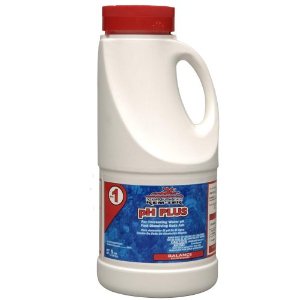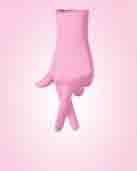« 2011 November | Main | 2011 September »
Saturday, October 29, 2011
Correcting acid-bleached areas on an acetate/cotton/nylon blend coat
Country or region: USA
Message: I have a coat that is a blend of acetate, cotton and nylon and the lining is 100 acetate. Bad story, my son became car sick and my coat was next to him. By the time we got home (we were out of town) the acid discolored my coat. it is not wearable now. Is there a dye I can use on this blend? the texture of the coat is plushy (if this is a word) and wavy.
Thursday, October 27, 2011
Country or region: United Kingdom
Message: Hello there,
My name is Ore and I have a burning thought/question and I hope you can help as I have thought for ages about this...How are these effects achieved? Is it through accordian folding and bulldog clips? Is it from resist bleach? Or is it through laying the garment flat, clipping some sections and then just using squirt bottles to cover the jeans? I'm dying to know, I hope you can tell me how it's done. I have attached the links below. Thank you. Really hope to hear from you soon.

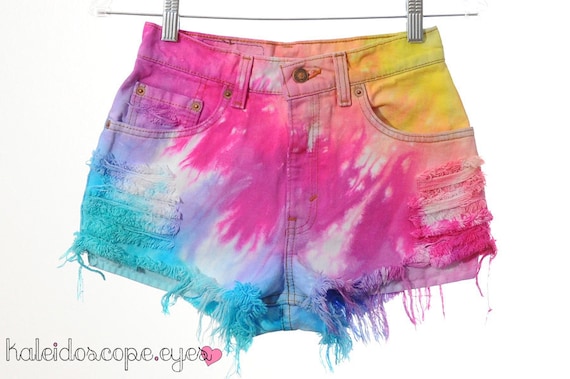
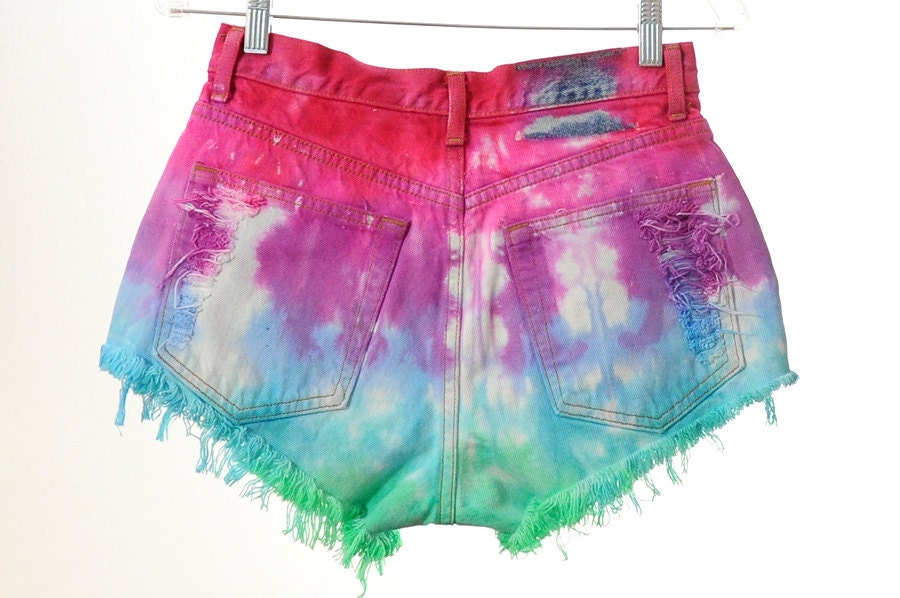

Wednesday, October 26, 2011
Message: According to "Jeanette's Fabric To Dye For," she fuses Jacquard metallics into dyed cottons. How exactly do you think this is done? She has the most beautiful dyed fabric and does not have classes or info at all on these methods or any of her spectacular techniques.
Although you wouldn't want to try to exactly copy another artist's work, Jeanette's beautiful fabrics are an inspiration for finding your own way.
(Please help support this web site. Thank you.)
Tuesday, October 25, 2011
How do you use the soda ash solution with drip dyeing, sprinkle dyeing, spray dyeing, and fabric painting methods when using Procion dye?
Country or region: Oklahoma , USA
Monday, October 24, 2011
If I add the soda ash to the dye bottles just before the children use it, how much soda ash should I use?
Country or region: Dallas, TX
Message: I am doing a (large) group tie dye project and thanks to your site I have assembled what I hope to be all the necessary supplies. We will be tie dying close to 600 children's t-shirts in the school colors of bright green and golden yellow using ProcionMX dyes. They will be done in art class with approximately 20-25 children's shirts dyed at a time. I am weighing two options for getting the soda ash onto the shirts:
THANKS!!!
Sunday, October 23, 2011
What color would I mix with gold to make gray?
Country or region: USA
Message: What color would I mix with gold to make gray? It's a pair of cotton curtains.
Friday, October 21, 2011
Message: For a costume, I need red and yellow striped socks. I can only find red/white striped ones that will work, and was wondering if you think I'd be able to dye the white stripes yellow without affecting the red colour at all? The fibre content is 65% recycled cotton, 15% acrylic, 20% spandex. Thanks so much for any advice/recommendations!!
I can only find red/white striped ones that will work, and was wondering if you think I'd be able to dye the white stripes yellow without affecting the red colour at all? The fibre content is 65% recycled cotton, 15% acrylic, 20% spandex. Thanks so much for any advice/recommendations!!
Thursday, October 20, 2011
Why does everyone say never use an aluminium pot when dyeing?

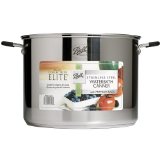

Ball Jar Collection Elite Stainless-Steel 21-Quart Waterbath Canner with Rack and Glass Lid




Columbian Home 33-Quart Jar Canner and Rack


Country or region: U.K.
Message: I want to try dyeing an acrylic yarn with disperse dyes. I bought a large electric soup pot that boils. The only problem is I think the lining of the pot is aluminium. What do you think might or will happen if I use this pot to dye with? Also, why does every one say never use an aluminium pot when dyeing?
(Please help support this web site. Thank you.)
Wednesday, October 19, 2011
Is it a mistake to dye a dry-clean-only polyester dress for a single wearing as a Halloween costume?
Country or region: Philadelphia, PA
Message: I read through your polyester dyeing page because lo and behold I have a polyester dress that is dry clean only that I'm trying to dye. I only need this for one night which is Halloween. It doesn't have to look perfect and after I'm finished with the dress I plan to throw it out. Will dyeing it still not be a good idea?
Tuesday, October 18, 2011
Would dyeing black cotton (72%), nylon 25% and spandex 3% blend shirt with black all purpose dye remove or hide shiny marks left by ironing?
Sunday, October 16, 2011


Textile Fibers, Dyes, Finishes and Processes: A Concise Guide
by Howard L. Needles




Textiles: Concepts and Principles
by Virginia Hencken Elsasser


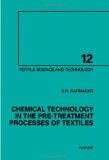

Chemical Technology in the Pre-Treatment Processes of Textiles, Volume 12 (Textile Science and Technology)
by S. R. Karmakar


Country or region: Indonesia
Message: Hi Paula-
How does one *add* a sizing or attractive finish after dying a cotton fabric? My "store bought" cotton prints have a surface that look so much perkier than my dyed cotton fabrics which look quite flat and dead. But the same cotton -even poorer quality- looks "richer" in the "store bought" fabric.
Are there any ways for the hand-dyer to improve the finish/ add life to the surface? It needn't look the same as commercially printed and dyed fabric, but I don't want it to be dead looking.
Is there is anyway to "make your own"? This would be good because we do not have an array of products in Indonesia like are available in the U.S. Or perhaps I could order some kind of industrial chemical that can be sprayed on like you would spray starch from a spray bottle and iron it in?
Friday, October 14, 2011
Ecological safety of Procion dyes

Environmental Aspects of Textile Dyeing
edited by R. M. Christie




Biodegradation of Azo Dyes (The Handbook of Environmental Chemistry)
edited by H. A. Erkurt




Phytoremediation Technologies for the Removal of Textile Dyes
by S P Govindwar and A N Kagalkar




The Artist's Complete Health and Safety Guide
by Monona Rossol
Country or region: US
Message: Hi. Ivy at Dharma suggested asking you. We dye with Procion dye. We are looking to see if it has any ecological qualities? We are dying on sustainable cottons and modal and checking to see if there is anything "green" about the dyes we're currently using. Appreciate any help you can offer.
Thursday, October 13, 2011
How should I dye some 50% cotton/50% polyester sheets?
Tuesday, October 11, 2011
I need to dye the tips of a 7" baby pink satin ribbon blue so the dye will be darker at the tips and fade as it goes up into the pink
Country or region: USA
Message: I need to dye the tips of a 7" baby pink satin ribbon blue. In doing so, I am looking for the dye be darker at the tips and fade as it goes up or toward the center into the pink, leaving the pink to be the center color of the ribbon. What is the best product to use to give me this look?
There are many dyes that can give a similar effect to what you're describing, but only if the satin has been woven from a natural fiber. If your satin ribbon was woven from a synthetic fiber, then the dye requirements will be entirely different.
Many people think that "satin" is a word for the fiber content, but it's not. Satin can be woven from any fiber. See my page, "How can I dye satin or charmeuse?".
Find the fiber content of your ribbon and then get back to me. If you have not yet purchased the ribbon, avoid ribbon that is made of polyester or acetate.
Thank you so much for responding. I do have the ribbon but it can be returned. I checked and it is 100% poly. Is it at all possible to achieve the effect I am looking for or should I just return it and get another type?? I need this for Sunday so I was trying to just get a few done.
Monday, October 10, 2011
Country or region: USA
Message: I have searched your site and it has proven very useful for information and data I will be using in a speech in a few days. Don't worry, properly cited it will be. I am still having trouble finding information on the mass production of tie dye though. I have done many searches and have found nothing on how companies produce tie dye. Is it hand dyed? Done with template or machine? I really don't know! This might be a bit out of your range of expertise but I just thought you might have more information than what I have found. Thank you for your time and consideration.
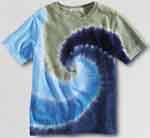
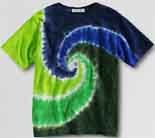
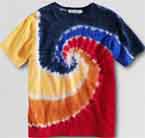
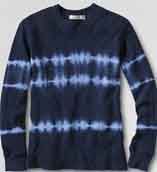
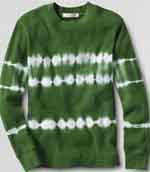
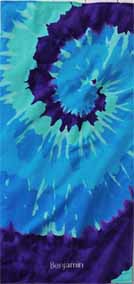
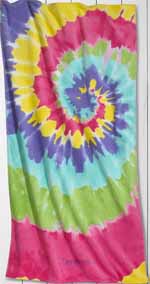
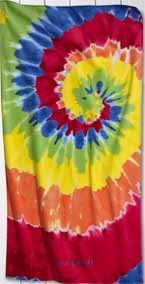
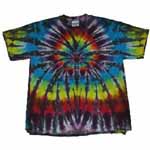
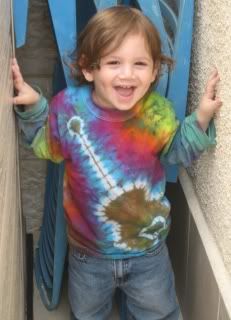



(The example on the left is by Brad Garrett at Phat Dyes; the second image is by Elisheva Ben Ze'ev, posted on the Dye Forum; the third is by dyer THC, posted elsewhere on the Dye Forum ; the fourth is from True Tie Dye; and the fifth is by Judy Sall, at her ArtFire store.)
Saturday, October 08, 2011
Tracking down Procion MX mixing primaries
Country or region: The Netherlands
Message: Hi Paula,
Your website has been a great help for me in my quest to learn about dyeing shammies as are used in diving. I have one question remaining for which I cannot seem to find the answer already at your site. It is about mixing Procion MX dyes. You actually posted a mixing table from a Dutch company, Dreamline (that does not seem to exist anymore), and my question is about the 'second' table. Could you tell me which (preferably Jacquard) color# would be for the Amber, Red Jasper and Azurite as mentioned in this table? The codes as MX-3R, MX-B and MR-3 I can not seem to retrace.
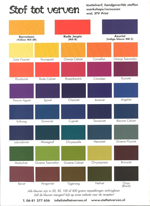
Thursday, October 06, 2011
Is it possible to make a UV reactive dye like (glow in the dark)?


Country or region: Canada
Message: Is it possible to make a UV reactive dye (glow in the dark)?
Tuesday, October 04, 2011
Is it possible to dye a brown cotton t-shirt black that has a printed design on it without dyeing the design as well?

Country or region: UK
Message: Is it possible to dye a brown cotton t-shirt black that has a printed design on it without dyeing the design as well?
Sunday, October 02, 2011
How can I dye t-shirts UT Burnt Orange with Procion MX dyes?
If your water is at all hard, and Texas does tend to have hard water in its streams, you should use sodium hexametaphosphate to soften the water you use, both for mixing dyes and for every load of washing, when removing the excess dye. This is because the hard water ions can cause some dye molecules to combine into complexes that are more difficult to wash out from the fabric. You can buy sodium hexametaphosphate from any major dye supplier. Don't use the Calgon that comes from the grocery store, because it contains completely the wrong chemical, though Calgon from Jacquard Products is fine.
Don't use Retayne or other cationic dye fixatives to fix fiber reactive dyes, such as Procion MX. Properly fixed MX dyes are more permanent than Retayne is. Retayne also has to be washed only in cool water in the laundry (after using hot water to apply it in the first place), to keep it from washing out. Furthermore, Retayne and other cationic dye fixatives tend to make dyes more susceptible to fading in bright sunlight. Retayne is a very good solution when you are working with inferior dyes, but the excellent Procion type dyes you've been using are better than Retayne.
Correcting acid-bleached areas on an acetate/cotton/nylon blend coat
Name: Susan
Country or region: USA
Message: I have a coat that is a blend of acetate, cotton and nylon and the lining is 100 acetate. Bad story, my son became car sick and my coat was next to him. By the time we got home (we were out of town) the acid discolored my coat. it is not wearable now. Is there a dye I can use on this blend? the texture of the coat is plushy (if this is a word) and wavy.
Is the coat washable, or is it labeled "dry clean only"? My experience with "dry clean only" acetate-lined clothing is that, when washed, the cotton exterior shrinks, while the acetate lining does not. As a result, the lining hangs down below the outer garment, and the way the sleeves lie becomes distorted. A skirt may become wearable again by cutting out the lining, if shrinkage has not left it too short, but it's hard to see that as being possible for a long-sleeved coat.
Step one is to wash the coat well. Anything you do with this coat must start with a thorough washing to remove not only any remaining traces of acid, but also any sort of dirt that might interfere with dyeing. Even the most thorough dry-cleaning is not sufficient, if you're going to do any dyeing, because dyeing in itself involves the same problems as washing, and the excess unattached dyes must always be washed out after application. Since washing is inevitable, you may as well find out up front whether or not it will destroy the coat.
After you have washed the coat, evaluate how well it survived. If it is still wearable, then you can go ahead and dye it. However, it is very difficult to dye over a discoloration like the one you describe. All dye is transparent, so the original bleached-out area will usually remain visible after dyeing, unless you use a multi-colored dye technique to cover up the variation. Take a look at my page, "How can I fix the bleach spots on my favorite clothing?". Try a permanent fabric marker to color in the bleached spots.
I would recommend that you try to remove the remaining dye in the coat, insofar as possible, before you dye it. Do not use chlorine bleach (common household bleach, which is based on sodium hypochlorite), because bleach destroys nylon. As a general rule, you should never use hypochlorite bleach on synthetic fibers. Instead of bleach, use a sulfur-based color remover, such as Rit Color Remover. You can find other suitable brand names of dye removers on my page, "What chemicals can be used to remove dye?". The easiest way to use color remover is in the washing machine, using the hottest water available; you may need two packets of color remover, depending on the size of your washer. Color removers are more effective when used at higher temperatures, so, if the washing machine method does not work, the stovetop method may; however, it's hard to find a non-aluminum pot large enough to heat a coat in on your stovetop.
If color remover doesn't work, perhaps it would make sense to use an acid to try to remove the color on the unaffected portions of the coat, since the problem was caused by the sensitivity of the dye in the coat to acid. Try washing it with hot water, along with a quart of distilled white vinegar. This might work well, or might not not at all, but it's probably worth a try.
After you've removed as much of the existing color in the coat as possible, then you can dye it. There are two choices for how to dye it. Probably your best choice would be to use an all-purpose dye, such as Rit dye, but only if you can find the old formula, not the new one; their recent change in formula means that new boxes cannot dye acetate, though they can dye cotton and nylon, while the old packages can dye acetate in addition to cotton and nylon. I don't usually like to recommend all-purpose dye, because it is poorly washfast, and the boxes or bottles of all purpose dye contain large quantities of detergent and salt, and only a tiny amount of dye, so they're more expensive than other dyes, but for a blend like your coat's, it's probably a good thing to try. Be sure to weigh your coat when it is still dry, so that you can judge how many packets of dye you will need to buy. A coat might weigh five pounds, while a single box of Rit dye will color only half a pound of cotton fabric to a bright or dark color, though it will color nylon a darker color with the same amount of dye, and less dye is required for paler shades.
Finding the old formula of Rit dye, the one that works on acetate, can be difficult, but it is not yet impossible (as of late October 2011). In my local Joann's fabric store, half of the boxed colors are from the old formula, and half from the new, but all of the bottled liquid dyes are from the new formula. If you order directly from the Rit dye company (Phoenix brands), you can request the old formula, which is still available in some colors but not in others. If you open a box of Rit dye and look at the paper packet inside, or look at the cap of a bottle of liquid Rit dye, you can see a color number; if the letters "ND" appear, then it is the new formula. Since the boxes are not sealed, it is possible to non-desctructively open the boxes in your local store to check for this.
Your other choice would be to use a combination of Jacquard's iDye, which is a direct dye that works on natural fibers such as cotton, with Jacquard's iDye Poly, which is a disperse that works on synthetic fibers such as acetate and nylon. The difficulty here is that iDye Poly gives rather pale colors on acetate unless you boil the fabric in the dye. Finding a cooking pot large enough to boil a coat in is a difficult problem, as, for solid colors, the pot must be large enough to allow the garment to move freely. I think it would cost less to buy a new coat than to buy a suitable huge dyeing pot.
If your coat is mostly cotton and nylon, then even the new formula of Rit all-purpose dye should be adequate. You can then use it in the washing machine, using the hottest water possible, so it's not necessary to invest in a dyeing pot. The acetate will stay its original color. This may not be a problem for the lining; it will be a problem for the outer portion of the coat, with its cotton/nylon/acetate blend, only if there is a large proportion of acetate. A small amount of acetate, such as 10% acetate, won't be a problem even if it remains completely undyed, assuming you've been able to remove enough of the original dye, but 50% acetate will make a huge difference and doom the project.
Covering the acid-belached stains with a permanent fabric marker may turn out to be your best bet, if you can find one in just the right color.
(Please help support this web site. Thank you.)
(Please help support this web site. Thank you.)
Thursday, October 27, 2011
Name: Ore
Country or region: United Kingdom
Message: Hello there,
My name is Ore and I have a burning thought/question and I hope you can help as I have thought for ages about this...How are these effects achieved? Is it through accordian folding and bulldog clips? Is it from resist bleach? Or is it through laying the garment flat, clipping some sections and then just using squirt bottles to cover the jeans? I'm dying to know, I hope you can tell me how it's done. I have attached the links below. Thank you. Really hope to hear from you soon.




Aside from the intentional holes and other damage to the fabric of the garments, those look very ordinary to me, very much like my first efforts at dyeing with a good tie-dyeing kit containing Procion MX dyes. The turquoise, fuchsia, and yellow are the most commonly used of all the Procion MX dye colors, straight out of the kit, while the blue, violet, and peach are the result of combinations of two of the three colors where they overlapped on the fabric, along with some additional dilution, probably from a large amount of liquid remaining in the garments from the soda ash pre-soak.
The first pair appears to have been loosely accordian-pleated with diagonal folds, probably tied loosely with rubber bands, presoaked in soda ash, and then a simple rainbow pattern applied across the folds, with a stripe of turquoise on the lower left leg of the shorts, fuchsia in the middle, and yellow at the upper right edge of the shorts, with orange where the yellow and fuchsia overlap, and purple and blue where the turquoise and fuchsia overlap. You can't get much more basic than that, once you start with a decent tie-dyeing kit.
The second pair appears to have been presoaked in soda ash, spread out flat, and had the dyes squirted on it. I don't think it was tied or clipped in any way. The edges of the pink stripe show the characteristic shapes that fuchsia (Procion Red MX-8B) tends to leave as it reacts with the fiber more quickly than the other colors. The other colors react more slowly, so they have more time to spread out smoothly. It's a nice effect that fuchsia leaves, which you can avoid, when you don't want it, by substituting a different red, Procion Red MX-5B. Unfortunately, it is more difficult to get other colors to mimic the fuchsia effect.
The other two pairs were made with similar techniques, though a red or a green may have been pre-mixed in a plastic bottle before application. If you have spare bottles, it's easy to mix any two of your other colors together to make a new color.
No bulldog clips appear to have been used. None of the binding appears to have been done tightly, as bulldog clips would. Any bleach was applied and washed out before the dye was ever involved; the shorts may have been both whitened and damaged by bleach, but the dyes have not been discharged. Discharged dyes do not just disappear, they also leave traces of themselves with more subtle, ghostly colors, as the results of the broken dye molecules that are left by bleach. That hasn't been done here.
This would be an ideal project for a first-time tie-dyer. Let me encourage you to try it for yourself. Whatever clothing you choose to dye should be white in color, and pre-washed thoroughly; its fiber content should be 100% cotton, with no polyester, or at least not much. Buy a good tie-dyeing kit, such as the ones sold in the US by PRO Chemical & Dye or Dharma Trading Company, or the Jacquard Products tie-dyeing kit, which is the very best of the tie-dyeing kits that you might be able to find in a local crafts or fabric store. Since you're in the UK, I encourage you to order a Procion MX tie-dyeing kit from George Weil or Kemtex Educational Supplies, or separately order the dyes Procion Yellow MX-8G or Procion Yellow MX-4G, Procion Red MX-8B, and Procion Turquoise MX-G, along with soda ash or washing soda, sodium hexametaphosphate as a water softener, rubber bands, plastic gloves, and plastic squeeze bottles with the pointy Yorker tips. George Weil does sell the small Funky Groovy Tie Dye Kit, made by Jacquard Products. For instructions, see the pages "Hand Dyeing - How to Do It: basic recipe for Procion MX dyes on cellulose or silk", and "How to Tie Dye - Complete Instructions".
(Please help support this web site. Thank you.)
(Please help support this web site. Thank you.)
Wednesday, October 26, 2011
Name: Carmen
Country or region: USA
Message: According to "Jeanette's Fabric To Dye For," she fuses Jacquard metallics into dyed cottons. How exactly do you think this is done? She has the most beautiful dyed fabric and does not have classes or info at all on these methods or any of her spectacular techniques.
I can't tell you Jeanette's exact methods, but I can get you started on your own work by telling you what to use for that sort of effect.
Jacquard Products manufactures an excellent line of fabric paint called Lumiere, with 32 different colors. It's a soft, lightweight acrylic fabric paint with a very good concentration of metallic or pearlescent pigment, depending on the color.
The basic method you're talking about would require at least two steps:
First, use Procion MX fiber reactive dyes to dye good PFD cotton or rayon fabric, either by the low water immersion technique or by hand-painting with the dye on soda-soaked fabric. Wash and dry the fabric. You can repeat this dyeing process with similar colors for a more intense effect.
Second, dilute Jacquard Lumiere metallic fabric paint with up to 25% its volume of water (e.g., add one-quarter ounce of water to one ounce of paint ). Try applying it with different techniques, including painting with a brush, sponging it on, or even diluting it by 25% with water and using an airbrush. Try painting on fabric that's been dampened with water. You will get a softer, more diffuse effect when painting on damp fabric than when painting on dry fabric.
For a greater dilution, using too much water can be a problem. Fabric paint that has been diluted more than the manufacturer recommends is more likely to wash off, or to rub off when it is dry. For greater transparency without loss of permanence, use Jacquard's #579 Flowable Extender as a diluent, in addition to adding water in up to 25% of the total volume of paint (including both the metallic paint and the clear extender in your total).
Note that the color of the paint may separate from the metallic if you over-dilute the paint with water. For example, over-diluted metallic copper contains brown paint plus the metallic sparkle. Since at least some of the original color of the dyed fabric will show through the fabric paint, choose your colors carefully so that the color of the fabric paint goes well with the color of the dyed fabric underneath.
After the paint is completely dry, heat set it as recommended by the manufacturer, using a hot iron or a commercial clothes dryer (a home clothes dryer may not get hot enough).
(Please help support this web site. Thank you.)
Tuesday, October 25, 2011
How do you use the soda ash solution with drip dyeing, sprinkle dyeing, spray dyeing, and fabric painting methods when using Procion dye?
Name: Michelle
Country or region: Oklahoma , USA
Message: How do you use the soda ash solution with the drip dyeing, sprinkle dyeing, spray dyeing, and fabric painting with dye methods when using Procion dye? I could not find this information in the instructional areas for these types of dyeing, nor in the gallery discriptions. I have found that I absolutely LOVE this dye! Thanks for all your help, and feel free to include the question and answer on your blog!
It's simpler than you've been thinking! Just presoak the fabric in soda ash solution, exactly as you would do for tie-dyeing. I usually use one cup of soda ash per gallon of water (that's 20 grams per liter), though as little as as much soda ash will still work. After fifteen minutes, or long enough for the soda ash to penetrate into the center of each fiber, use gloved hands to remove the fabric from the bucket, squeeze out as much liquid as you easily can, and spread it out on your work surface, ready for the dye. This is step 5 on the "How to Hand Dye with Procion MX Dye" page.
For each of the methods you mention, I like to use the fabric still damp from the soda ash solution. Another option is to line-dry the fabric with the soda ash in it. The soda ash powder will stay in the fabric even after it dries. It can be used for tie-dyeing, spray painting with dye, and directly painting the dye on to the fabric. (Obviously there's no point in using dry fabric with the dry dye powder technique, since some moisture is needed for any dye reaction to occur.) The results with dried-in soda ash are a little different than using damp fabric, since the dye tends to move less on the fabric when there is less moisture present.
If you choose to dry the soda ash into the fabric, don't use a clothes dryer for the drying step. For one thing, it will make a mess of your dryer; you don't want to leave soda ash in the drum to get on the next load of ordinary laundry that you dry, so you'd have to scrub out the entire inside surface of the clothes dryer. Furthermore, it can be dangerous. More than one dyer has reported a fire in the clothes dryers as the result of machine drying fabric with soda ash in it; apparently cotton fabric is much more prone to catch on fire when it is at a high pH. (There is no risk in machine drying fabric whose soda ash has been rinsed out.) So, it's important to use line-drying instead of machine drying. Be careful if you hang the soda-ash-wet fabric on a line over your lawn, though, dripping on to your grass or plantings, because exposure to too much of the sodium in soda ash is not good for plants.
For drip dyeing, spray dye, fabric painting, and tie-dyeing, it is also possible to add the soda ash to the dye mixture just before applying it to dry, unsoaked fabric, or to fabric that's been dampened with a little plain water. The drawback is that the dye in the mixtures will be significantly used up an hour or so after you add the soda ash to it, so it will produce weaker and weaker colors. If you want to add soda ash directly to your dye mixtures, use 1 teaspoon of soda ash for one 16-ounce bottle of dye (containing two to four tablespoons of dye powder).
When painting the dye directly on to the presoaked fabric, whether it's wet or dry, be careful to pour out just enougb dye to use in the next hour or so. If you use a paintbrush or other tool, such as a sponge, you will pick up some soda ash from your fabric each time that you touch it. This is true whether you use wet or dry pre-soaked fabric. As the soda ash is carried back to your dye container on your brush, enough will get into the dye to make it start to go bad. A dye mixture that's kept in a separate bottle, so that it does not get contaminated with soda ash, should stay good for at least a week.
(Please help support this web site. Thank you.)
(Please help support this web site. Thank you.)
Monday, October 24, 2011
If I add the soda ash to the dye bottles just before the children use it, how much soda ash should I use?
Name: Kathy
Country or region: Dallas, TX
Message: I am doing a (large) group tie dye project and thanks to your site I have assembled what I hope to be all the necessary supplies. We will be tie dying close to 600 children's t-shirts in the school colors of bright green and golden yellow using ProcionMX dyes. They will be done in art class with approximately 20-25 children's shirts dyed at a time. I am weighing two options for getting the soda ash onto the shirts:
- 1) having the children tie their designs and then soaking for a few minutes (5 to 10) in large buckets of water and soda ash. Then an adult can wring the shirts out before the Dye is applied.
- 2) mixing the soda ash into the squeeze bottles of dye. (I cannot seem to find the ratio on your site but I know this can be done for painting techniques.)
THANKS!!!
Both of the methods you're considering will work fine. I've always used the first one, but the second one is a perfectly good choice.
I agree with you about not letting the children tie the shirts after they have been soaked in soda ash. I don't even do that myself, since the soda ash is so irritating to the skin that gloves MUST be worn, but wearing gloves is difficult while tying. The fingers of the gloves tend to get caught in the rubber bands or artificial sinew while you are tying. It's better to use plain water to dampen the shirts, if you want the moisture's help in making crisp bindings, or skip the water altogether, and then soak the tied garments in the soda ash.
The biggest drawback to mixing the soda ash directly with the dye is that it may not stay good for more than an hour after you do. When you add the soda ash to the dye mixtures, the dye begins immediately to react with the water. This will be fine if you mix up a different set of dye bottles for each class period, and add the soda ash only after class has started, perhaps while the children are tying their shirts. Just don't try adding the soda ash to all of the dye dye bottles in the morning, hours in advance. If you do, the classes that meet later in the day will have very pale results.
There's a recipe for how much soda ash to use on my page about dye thickeners. If each of your dye bottles contains 16 ounces of dye (half a liter), then the amount of soda ash to add is one teaspoon (5 milliliters). For a one-cup (8 ounce) bottle of dye, add half a teaspoon of soda ash. (Slightly too much or too little will be fine.) Be sure to get all the dye, urea, and water softener (if needed) mixed together well in advance, either in the morning or one or two days in advance, so that the only thing you will need to add in class will be the soda ash itself. (Dye thickener is entirely optional, so you don't have to bother with it.) Mixing up the dye itself takes too long for that to be left until classes begin.
If you're not sure how much dye you'll need, see "How much Procion MX dye should I use?".
(Please help support this web site. Thank you.)
(Please help support this web site. Thank you.)
Sunday, October 23, 2011
What color would I mix with gold to make gray?
Name: Paula M.
Country or region: USA
Message: What color would I mix with gold to make gray? It's a pair of cotton curtains.
Getting a truly neutral color sometimes takes more than one step. First, overdye your curtains with a color as close to to the opposite color on the color wheel as you can manage, that is, the complementary color. If the color you obtain from your first attempt is not quite as neutral a gray as you want, then, after washing and drying your fabric, look at what color cast you have, and choose its complement in order to correct your color to neutral.
The complementary color for yellow is purple, while the complementary color for orange is blue. When you say "gold", I can't be sure whether you mean a golden yellow, which is to say an orangish yellow, or a slightly brownish yellow. The most likely complement will be a slightly purplish blue.
The quickest way to find the true complement of any color is to look for its afterimage. With a sheet of plain white paper ready to hand, in a good light, fix your eyes on one spot in the middle of the gold curtains. Keep staring at the gold for a full sixty seconds, then suddenly switch your eyes to look at the center of the white paper. Instead of appearing a neutral white, for a few seconds you will see that the paper appears to be blue. The hue that you see on the white paper is the complement of the gold color on which you have temporarily exhausted your color vision. That's the color of the dye that you should use.
Since your curtains are made of cotton, I strongly recommend that you use a fiber reactive dye, such as Procion MX dye. Other brands of fiber reactive dyes you might be able to find include Dylon Permanent and Tulip Permanent dye. It's best to avoid all purpose dyes, such as Rit, because their colors are less predictable, and they fade quickly in the laundry. If you're willing to accept those limitations, you can use all-purpose dyes. For the widest possible choice of pre-mixed dye colors, I recommend that you look at Dharma Trading Company, or PRO Chemical & Dye, or any retailer who sells Jacquard Procion MX dyes. For a list of places from which to order dye, see my page, "Sources for Dyeing Supplies Around the World".
A top-loading washing machine provides the easiest way to dye a large item to a solid color. You'll need to find a recipe for the specific type of dye you choose to use, so that you can be sure to get all of the ingredients you'll need before you start. See my page, "How can I dye clothing or fabric in the washing machine?", for information about washing machine dyeing, and for links to various recipes.
(Please help support this web site. Thank you.)
(Please help support this web site. Thank you.)
Friday, October 21, 2011
Name: Kelly
Country or region: USA
Message: For a costume, I need red and yellow striped socks.
 I can only find red/white striped ones that will work, and was wondering if you think I'd be able to dye the white stripes yellow without affecting the red colour at all? The fibre content is 65% recycled cotton, 15% acrylic, 20% spandex. Thanks so much for any advice/recommendations!!
I can only find red/white striped ones that will work, and was wondering if you think I'd be able to dye the white stripes yellow without affecting the red colour at all? The fibre content is 65% recycled cotton, 15% acrylic, 20% spandex. Thanks so much for any advice/recommendations!!Since your socks are 60% cotton, they should be easy to dye, assuming that the different-colored stripes don't have different fiber contents. (We don't want to find out that all of the cotton is in the red stripes, so that the white stripes are all hard-to-dye acrylic!) The best choice would be a cool water fiber reactive dye for cotton, such as Procion MX dye, because the 20% spandex content should, ideally, be kept at or below a temperature of 104°F. It's usually best to not even bother to try to color the spandex in a bland; see How to Dye Spandex. If the red stripes are bright red, then overdyeing them with yellow will leave them red, or turn them to a somewhat orangish red. Will that work for your costume? If not, you can use a tie-dye squirt bottle to apply yellow dye only to the white stripes, after first soaking in soda ash as always for tie-dyeing.
Buy some yellow Procion MX dye, or yellow Dylon Permanent dye, or yellow Tulip One Step Fashion dye, if you can. The best local art supply stores might carry Procion MX dye, and even the worst local crafts store ought to carry a Jacquard brand tie-dyeing kit, or a Tulip tie-dyeing kit, either of which contains yellow dye that will perfectly meet your needs. The Jacquard Procion MX dye and the Jacquard tie-dyeing kits are the best choice; avoid Jacquard's iDye dye, which is a hot water dye and therefore not suitable for spandex blends. If you can't buy the right dye locally, you can order online for overnight delivery of a yellow Procion MX dye from Dharma Trading Company.
Since only 60% of the fiber blend in your socks is dyeable cotton, use a very strong amount of dye to dye it yellow. The acrylic fibers will stay white, as will the spandex fibers if you use a cool-water dye, but the overall effect will be yellow enough for your costume. If the yellow comes out too pale, you can always repeat the dyeing with twice as much dye powder. For dyeing with Procion MX dye, you will also need soda ash, but that is included in the tie-dye kits and the One Step dye kits.
If you can't find any brand of fiber reactive dye, the fall-back is all-purpose dye, such as Rit, which is easy to find although it is almost always an inferior choice for dyeing. All-purpose dye would be a poor choice for you because it bleeds in the wash, every time, and, as a result, does not stay bright very long. It also works best in hot water that is well above the maximum that spandex can tolerate. However, for a one-time-only costume, Rit dye will work well enough. Compromise on the water temperature, keeping the water below 140°F so as to not totally ruin the spandex. Spandex is much happier in much cooler water, but all-purpose dye works best at or above 185°F.
(Please help support this web site. Thank you.)
(Please help support this web site. Thank you.)
Thursday, October 20, 2011
Why does everyone say never use an aluminium pot when dyeing?
Name: Christine
—ADVERTISEMENTS—
A 33-quart or 21-quart stainless steel or enamel canning pot will work safely with any sort of fabric dye.

Ball Jar Collection Elite Stainless-Steel 21-Quart Waterbath Canner with Rack and Glass Lid

Columbian Home 33-Quart Jar Canner and Rack
Country or region: U.K.
Message: I want to try dyeing an acrylic yarn with disperse dyes. I bought a large electric soup pot that boils. The only problem is I think the lining of the pot is aluminium. What do you think might or will happen if I use this pot to dye with? Also, why does every one say never use an aluminium pot when dyeing?
Aluminum reacts with both acids, such as vinegar, and bases, such as soda ash or baking soda. You should never use an aluminum pot for any dyeing recipe that calls for either an acid or a base as an auxiliary chemical. (Don't cook vinegar-containing food in aluminum cookware, either, as it will spoil the cookware and give the food an unwanted metallic taste.) This means that an aluminum pot is not very versatile as a dyeing pot, as it can't be used with acid dyes for wool, nor with reactive dyes for cotton and linen. Both the soda ash used with reactive dyes, and the acids used with acid dyes, will dissolve part of the metal into your dyebath, interacting with the dye as a mordant, whether you want it to or not, and leaving permanent etching on the inside of the pot. However, it can be used for those few dyes that can be applied with neither an acid nor a base, including the disperse dyes you are interested in using.
Employees of Jacquard Products have on occasion said that you can use an aluminum, enamel, or stainless steel pot for dyeing with their disperse dye, iDye Poly. The package instructions now say to use enamel or stainless steel, but at one time included aluminum among the options. Although the small number of aluminum ions liberated at a neutral pH might affect the color of some dyes, the effect is far milder than the effect of other metal ions, such as copper, tin, or iron, and is apparently not a big problem for any of the dyes in the iDye Poly line.
Other brands of disperse dye may be preferable, if you can get them, because there are more colors available. The recipes provided for use with those dyes may include an acid or a base, though they should be able to work with the same recipes as the Jacquard brand of disperse dye. Be sure to read ProChem's instructions for "Immersion Dyeing Acrylic using PROsperse Disperse Dyes". [PDF]
I don't know whether your results will be as good if you leave out the citric acid or vinegar they call for, but chances are probably pretty good since there are other recipes elsewhere that don't call for it. Aljo Mfg's instructions for using their "Acetate - Nylon" range of disperse dyes on acrylic do not call for any acid or base at all. See the Aljo Mfg web site; here is a direct link to the directions.
Dyeing acrylic with disperse dye is more pleasant than dyeing polyester, because you don't need the dye carrier additive that smells so bad. Jacquard Products includes this as a separate packet within the package of iDye Poly; other brands offer it as a separate auxiliary chemical. It's completely unnecessary to use the dye carrier when dyeing acrylic, as the dye carrier is useful only for polyester. You will not be able to get an intense dark color on acrylic with disperse dyes, with or without the dye carrier, but the dyes are less toxic than other dyes for acrylic, and far more effective than any dye intended for use on natural fibers.
A general rule about choosing pots for dyeing is that you should never plan to reuse them for food. Unless you're using only food coloring (which makes a surprisingly good dye on wool but does not work at all on cotton or synthetics), you should assume that a dye is toxic and possibly carcinogenic. Dyes that are perfectly safe to use with normal safety precautions are considered unsafe to use in food preparation containers, in case some trace of a chemical, that is eventually found to be moderately carcinogenic or otherwise toxic, later turns out to have been in the dye. This is why dyers prefer to have an all-purpose dyeing pot that can be used for any sort of dye, but that will not be returned to the use of cooking food.
For more information about choosing a dyeing pot, see the following two articles:
(Please help support this web site. Thank you.)
Wednesday, October 19, 2011
Is it a mistake to dye a dry-clean-only polyester dress for a single wearing as a Halloween costume?
Name: Laura
Country or region: Philadelphia, PA
Message: I read through your polyester dyeing page because lo and behold I have a polyester dress that is dry clean only that I'm trying to dye. I only need this for one night which is Halloween. It doesn't have to look perfect and after I'm finished with the dress I plan to throw it out. Will dyeing it still not be a good idea?
The standards for dyeing costumes are lower than those for dyeing an outfit you want to look perfect again and again. If there's a little tear in a costume, you can sew it up. If the hem comes out, you can tack it up temporarily, instead of needing to do a proper job of rehemming. If there's some inconsistency in color, well, the light will probably be dim enough that no one will notice.
I'm not sure whether you will want to truly dye this dress, or if it will be enough for you to use fabric paint on it. Fabric paint wears off with time, and never looks nearly as smooth and even as dye, but it can be applied at room temperature and heat-set with an iron, unlike polyester dye, which requires extensive boiling. You won't care about the wearing-off problem, since you'll be wearing this dress only once, and you might not mind inconsistencies in the color. For the most dye-like effect, you can use a very thin fabric paint like Dye-Na-Flow or Dharma Pigment Dye (which is actually a fabric paint, not a dye). Like dyes, most fabric paints work only to turn a light-colored garment to a darker color; neither of these will cover a darker color to make it lighter, but another fabric paint, called Neopaque, will, though it requires more paint to cover, and will mess up the feel of the fabric more.
If you think you'd rather use dye, since it gives better results than fabric paint (though for more trouble), before you spend money on the dye, wash this dress in very hot water. If it survives, then yes, you can go ahead and dye it for your costume, using disperse dye. If it doesn't survive washing, throw it away. Lots of dry-clean-only garments will survive washing, so, if you don't mind risking having to throw the dress away, you may as well try it. It's not worth buying the dye until after you've determined that the dress will survive washing.
Don't ever try to dye polyester with a dye intended for natural fibers, such as Rit all-purpose dye! It won't work for even one wearing. It will come out of the polyester fabric the first time you wash it, and yes, it is essential to wash a dress you've dyed, even if you will wear it only once. If you don't wash the dress out after dyeing, dye particles left in the fabric will rub off onto you and anything you touch, including any furniture or car seat you sit on.
The only type of dye that will work on your polyester dress is called disperse dye. If you have a very good art supply store nearby, they might carry this dye in the form of "iDye Poly", which is made by Jacquard Products. If you can't find this dye locally, then you will have to order it online, or you can order another brand of disperse dye from PRO Chemical & Dye or Aljo Mfg. The dye must be applied in boiling water, and you have to keep it boiling for some time; it's not enough to just heat the water beforehand. This means that you will need a large cooking pot to boil the dress in, with the dye. The large cooking pot is by far your biggest expense for this project.
(Please help support this web site. Thank you.)
(Please help support this web site. Thank you.)
Tuesday, October 18, 2011
Would dyeing black cotton (72%), nylon 25% and spandex 3% blend shirt with black all purpose dye remove or hide shiny marks left by ironing?
Name: Anna
Country or region: Canada
Message: Hi, thank you for your very informative website!
Would dyeing black cotton (72%), nylon 25% and spandex 3% blend shirt with black all purpose dye remove or hide shiny marks left by ironing?
Would dyeing black cotton (72%), nylon 25% and spandex 3% blend shirt with black all purpose dye remove or hide shiny marks left by ironing?
No, I don't think that dyeing should make any difference that will correct physical damage created by ironing at too hot a temperature. If they have survived washing and drying again, then I think the shiny marks will persist even after dyeing.
Instead, try rubbing them with a towel or a soft brush, while the fabric is still completely dry. Sometimes this works to raise the flattened fibers again.
To avoid creating similar marks on another garment, in the future, turn clothing inside-out to iron, use a pressing cloth, or take care to use a lower temperature setting on your iron.
(Please help support this web site. Thank you.)
(Please help support this web site. Thank you.)
Sunday, October 16, 2011
Name: Katherine
—ADVERTISEMENTS—

Textile Fibers, Dyes, Finishes and Processes: A Concise Guide
by Howard L. Needles

Textiles: Concepts and Principles
by Virginia Hencken Elsasser

Chemical Technology in the Pre-Treatment Processes of Textiles, Volume 12 (Textile Science and Technology)
by S. R. Karmakar
Country or region: Indonesia
Message: Hi Paula-
How does one *add* a sizing or attractive finish after dying a cotton fabric? My "store bought" cotton prints have a surface that look so much perkier than my dyed cotton fabrics which look quite flat and dead. But the same cotton -even poorer quality- looks "richer" in the "store bought" fabric.
Are there any ways for the hand-dyer to improve the finish/ add life to the surface? It needn't look the same as commercially printed and dyed fabric, but I don't want it to be dead looking.
Is there is anyway to "make your own"? This would be good because we do not have an array of products in Indonesia like are available in the U.S. Or perhaps I could order some kind of industrial chemical that can be sprayed on like you would spray starch from a spray bottle and iron it in?
The main difference in the fabric, I think, is mercerizartion. Mercerization is typically done after weaving and before dyeing, though it can also be done to thread or yarn. Can you buy mercerized cotton? Here in the US we do have some choices of mercerized cotton, so I hope you can find it there. I'm sure it is made there; it's just a question of finding a good source. The mercerization process takes away surface fuzziness that dims down the colors of the dyes by scattering light. It makes the colors of the dye you use appear much more intense and crisp. Or do you ever work with rayon? Rayon is made of the same sort of cellulose as cotton, but the chemical processing results in an effect similar to mercerization.
We can buy a high quality fabric softener, which will reduce any stiffness remaining after the dyeing process. Some suppliers for hand dyeing sell it under the name "Milsoft". It is much better than the grocery store fabric softeners, and lacks the horrible perfumes that most of those have. Unfortunately, it will not create a sheen, or make colors appear to be more intense.
We can use more dye to get a greater color intensity to mimic the greater color intensity provided by mercerized fabric, but there is a limit to how far you can go with this, and it won't impart the sheen of mercerization.
Doing mercerization yourself is a huge challenge, and not suitable for every dyer. It involves the use of caustic soda (also known as lye, NaOH, or sodium hydroxide), which, if it splashes on you, can cause serious burns. It's especially important to prevent splashes into the eyes because they can cause permanent blindness. It is possible to work with caustic soda safely, but it's important to do so carefully and to know what the worst is that could happen.
The difficult thing about home mercerization is that it requires that the fabric be stretched during the treatment. You can't just dump the fabric in a bucket with the caustic soda and stir, if you want the maximum resulting luster, or to prevent huge amounts of shrinkage. The process causes a great deal of shrinkage, if the fabric is not held under tension while it is exposed to the caustic soda. I've never tried it, but a couple of members of the DyersLIST mailing list have, Doug Wilson and Olli Niemitalo; their experiences can be read by joining the DyersLIST mailing list and searching the archive.
If you were to do mercerization yourself, you would have to build some sort of framework on which to stretch your fabric, and acquire some sort of tank in which to immerse them in as small a volume of liquid as is practical. Caustic soda is easy to buy anywhere, I think. You could learn the appropriate safety measures: always add caustic soda to water, never water to caustic soda; expect the water to get very hot, temporarily, when you add the caustic soda; always wear excellent googles, or a full face mask, shaped like the masks welders wear, but with transparent plastic instead of dark tinted plastic; wear a lab coat and a waterproof thick apron; work in an area whose floor can be easily washed down; always have plenty of water available for emergency showers and washing.
However, I'm really not at all sure you want to try this. I recommend that you instead look hard for sources of mercerized fabric. I will find a few examples from the US so that you can look for something similar....
(Please help support this web site. Thank you.)
Friday, October 14, 2011
Ecological safety of Procion dyes
Name: Tammy
—ADVERTISEMENTS—

Environmental Aspects of Textile Dyeing
edited by R. M. Christie

Biodegradation of Azo Dyes (The Handbook of Environmental Chemistry)
edited by H. A. Erkurt

Phytoremediation Technologies for the Removal of Textile Dyes
by S P Govindwar and A N Kagalkar

The Artist's Complete Health and Safety Guide
by Monona Rossol
Country or region: US
Message: Hi. Ivy at Dharma suggested asking you. We dye with Procion dye. We are looking to see if it has any ecological qualities? We are dying on sustainable cottons and modal and checking to see if there is anything "green" about the dyes we're currently using. Appreciate any help you can offer.
There are two sides to this story: how much damage does using the dyes do to the environment, if any, and how much damage is done when the dyes are first manufactured?
As far as the second is concerned, it's funny that Dharma sent you to me, because only our dye suppliers can find out for us where the dyes we use are manufactured. Are the dyes manufactured in facilities that treat their wastewater and avoid damaging the environment, or are they manufactured in facilities whose bad practices cause environmental damage that will take decades to pay for? All we can do is ask our dye suppliers, including Dharma, to find some sort of certification concerning the environmental standards practiced by each factory from which their suppliers purchase dyes.
There has been quite a bit of discussion on my site about the environmental aspects of using dyes. I was just replying to another question on this topic, from Candy Glendenning at Candied Fabrics:
Paula, If anyone knows the answer to this, you do! I've searched through your website and forum, and haven't found a discussion about this, although maybe it's there. I have many people that ask whether my dyeing method (soda ash with Procion MX fiber reactive dyes) is eco-friendly and non-toxic. What are your thoughts on this? Or do you have someplace to point me to that helps me compare using these to other ways of coloring cloth? Thanks! Candy
Here are some pages with discussions on that topic. More than you expected, I'm sure. More than I realized I had!
"Are Reactive Dyes eco-friendly?"
"Are Procion dyes are considered "green", i.e. environmentally harmless?"
"Are natural fabric dyes best for the environment?"
"How do you minimize the toxic outflow in the waste water of the Procion particulates?"
"What are low-impact dyes, and why are they considered low-impact on the environment?"
"Explaining the safety of Procion dye to 'organic' moms"
"Is it safe to dye a sling for my baby?"
"If I buy the Tie Dye kit by Jacquard it will be non-toxic once it is mixed?"
"Procion Dyes in the environment"
"Toxicity of Procion Dyes"
"Dye safety and bladder cancer"
Here are some pages with discussions on that topic. More than you expected, I'm sure. More than I realized I had!
"Are Reactive Dyes eco-friendly?"
"Are Procion dyes are considered "green", i.e. environmentally harmless?"
"Are natural fabric dyes best for the environment?"
"How do you minimize the toxic outflow in the waste water of the Procion particulates?"
"What are low-impact dyes, and why are they considered low-impact on the environment?"
"Explaining the safety of Procion dye to 'organic' moms"
"Is it safe to dye a sling for my baby?"
"If I buy the Tie Dye kit by Jacquard it will be non-toxic once it is mixed?"
"Procion Dyes in the environment"
"Toxicity of Procion Dyes"
"Dye safety and bladder cancer"
Candy wrote,
Reading through all of those posts, I'm assured that the dyes that I use have low impact on the environment - the info about microbes breaking them down is very helpful. BUT...I think the biggest issue of all is the PRODUCTION of these dyes, right? How do we know they're being made responsibly? The links to the Dystar EU-label and Oeko-tex Standard 100 certifications are out of date, probably because Dystar isn't manufacturing them anymore. And a search for ProcionMX manufacturers just takes me to distributors, and YOU! ;-)
As Candy says, we dyers don't know anything about which factories our dyes are made from, and have no idea whether some of them are more environmentally responsible than others. We need to ask Dharma Trading Company and all of our other dye suppliers to find this information from their suppliers, and provide some sort of certification as to the acceptability of the dye manufacturers in question. It seems likely that some are better than others. Facilities in Europe must have much more stringent regulations to follow than those in China, but I think that all or most of our dyes now are most likely manufactured in China or India. What are the European regulations on environmental standards for the manufacture of dyes imported from overseas? The regulations I know about restrict contamination of dyes with heavy metals and carcinogens, but don't, as far as I know, mention the environmental practices at their factories of origin. We need more information on this question.
(Please help support this web site. Thank you.)
(Please help support this web site. Thank you.)
Thursday, October 13, 2011
How should I dye some 50% cotton/50% polyester sheets?
Name: Ann
Message: I have an elementary question for you....... I need to dye some 50/50% cotton polyester blend sheets a medium shade of caramel. I read your Q&A's on polyester dyeing but I'm still in a quandary as to how to do the project. I had planned to use my top load washing machine but discovered that poly requires immersion dyeing. I could really use your help!
Thanks so much for your kind attention and your wonderfully informative website!
What I would do is dye only the cotton portion of the sheets, using Procion MX fiber reactive dye in the washing machine. (You'll also need soda ash or washing soda, a large quantity of ordinary non-iodized salt, and water softener chemical.) The cotton in the blend will pick up the Procion dye and bond to it permanently, while the polyester blended with it will remain white after washing. This generally works fine, as long as you don't mind getting somewhat muted colors. It's no good at all for getting a rich deep black or a brilliant scarlet, but it's okay for subtler effects.
Thanks so much for your kind attention and your wonderfully informative website!
Dyeing the polyester would be far more trouble than it's worth, since it would require buying a cooking pot huge enough for the sheets to move around in freely as you boil them with the special polyester dye. It would be a significant investment, since you shouldn't plan on reusing a dyeing pot for food. In addition, the experience of boiling the smelly intensifier chemical along with the dye is no fun. It'd make more sense (and cost less) to buy new cotton sheets to dye than to buy an expensive huge cooking pot to dye cotton/poly blend sheets.
You can't get a really dark color when you're dyeing only 50% of the fiber content, but fortunately you're only trying for a medium-intensity hue. The color will be blander than you would get when dyeing 100% cotton or rayon, but it should meet your needs.
(Please help support this web site. Thank you.)
(Please help support this web site. Thank you.)
Tuesday, October 11, 2011
I need to dye the tips of a 7" baby pink satin ribbon blue so the dye will be darker at the tips and fade as it goes up into the pink
Name: Cheri
Country or region: USA
Message: I need to dye the tips of a 7" baby pink satin ribbon blue. In doing so, I am looking for the dye be darker at the tips and fade as it goes up or toward the center into the pink, leaving the pink to be the center color of the ribbon. What is the best product to use to give me this look?
There are many dyes that can give a similar effect to what you're describing, but only if the satin has been woven from a natural fiber. If your satin ribbon was woven from a synthetic fiber, then the dye requirements will be entirely different.
Many people think that "satin" is a word for the fiber content, but it's not. Satin can be woven from any fiber. See my page, "How can I dye satin or charmeuse?".
Find the fiber content of your ribbon and then get back to me. If you have not yet purchased the ribbon, avoid ribbon that is made of polyester or acetate.
Thank you so much for responding. I do have the ribbon but it can be returned. I checked and it is 100% poly. Is it at all possible to achieve the effect I am looking for or should I just return it and get another type?? I need this for Sunday so I was trying to just get a few done.
Thanks for letting me know about the fiber content of the ribbon. Even though polyester is more difficult to dye than natural fibers (or even nylon or rayon), all is not lost. If you use the right product, you should be able to achieve the effect that you want.
There are different ways you can go with this. The easiest way, by far, would be to use a very thin fabric paint, as a mimic for dye. Probably the thinnest of all of the fabric paints that will work on polyester is Jacquard Product's Dye-Na-Flow; it's a very thin paint that works like a dye, and that is said to work okay on polyester, unlike many fabric paints. (ColorHue is popular for dyeing silk ribbons, but it won't work on polyester.) I hope one of your local art supply shops carries Dye-Na-Flow, so that you don't have to wait for even a next-day online order to reach you in time to do the work for this Sunday.
If you take a blue jar of Dye-Na-Flow fabric paint, you can use some of it undiluted at the tips, then dilute some with water and paint the next part of the ribbon, dilute it further and paint the next section, etc., for a gradual lightening of the intensity of the blue color that you are using. (I hope you have at least one spare ribbon to test your technique on!) Unfortunately, you cannot continue to dilute the Dye-Na-Flow indefinitely, for a very pale color, because too much water will make the paint wear off more quickly later on, as the result of not leaving a high enough concentration of glue in the mixture, with excessive dilution. This should not be a problem if the ribbons will not be washed many times. If they do have to be able to survive much laundering, then the way to continually dilute the fabric paint in color, without diluting its strength, is to also buy a small jar of the colorless extender that Jacquard Products makes for the fabric paint, and use it along with water to dilute the blue Dye-Na-Flow fabric paint.. They use the same extender for Dye-Na-Flow as for their other paints, Lumiere and Neopaque, the Neopaque Colorless Extender, but it is thicker than Dye-Na-Flow. After the ribbons have dried, use a hot dry iron to heat-set the binder in the fabric paint.
It doesn't seem likely that you'll want to use a true dye. Polyester refuses all types of dye except for disperse dye. You can buy disperse dye easily in the form of Jacquard Products' "iDye Poly" (not to be confused with their plain iDye, which is only for natural fibers), but applying it to polyester requires boiling along with a smelly intensifier chemical (which is included in the packet of dye), and standing over that pot while gradually removing more of the ribbon from the pot, so that part of the ribbon has less exposure to the dye, sounds like an unpleasant experience to me.
I hope that you are already clear on what the color results will be. A rich blue on top of pink will be blue, certainly, perhaps with a bit of a purple tinge, but as you lighten the blue, the pink will show through more and more, creating violet. The gradient effect can be very pretty. You can't go straight from blue to pink without violet in between, unless you keep the blue very dark and avoid trying for the gradual-fading color effect (also known as the gradient or ombré effect).
If you do want to return the ribbon, see what the available alternatives are, since you don't have time to order online now (though Dharma Trading Company does do next-day shipping; their silk ribbon is all white, so you'd also have to dye the ribbon pink, but they have all the other products you might want to use.) A silk ribbon, made of real 100% silk, is extremely easy to dye with all sorts of dyes and fabric paints (and works even better with Dye-Na-Flow than polyester does); it works well even with fabric markers. Rayon ribbon is easy to dye, too, using the same Procion dyes that are used for tie-dyeing, though in a very different effect than tie-dyeing. I would advise that you sacrifice one of your polyester ribbons as a test, to see whether you can get a good result with gradual dilutions of Dye-Na-Flow fabric paint. If you don't like the result, can you return the remaining ribbons? Always buy enough extra pieces to use for testing your materials and your techniques.
(Please help support this web site. Thank you.)
(Please help support this web site. Thank you.)
Monday, October 10, 2011
Name: Micah
Country or region: USA
Message: I have searched your site and it has proven very useful for information and data I will be using in a speech in a few days. Don't worry, properly cited it will be. I am still having trouble finding information on the mass production of tie dye though. I have done many searches and have found nothing on how companies produce tie dye. Is it hand dyed? Done with template or machine? I really don't know! This might be a bit out of your range of expertise but I just thought you might have more information than what I have found. Thank you for your time and consideration.
I can't give you much in the way of real information, only some speculation and a few observations.
There are many tie-dyes that are extremely repetitive in style and color, and very inexpensive. These most likely represent cheap labor in places such as China or India. They appear to be tied and have dyes squirted upon them, then untied and excess dye washed out, just as in the standard hand tie-dyeing technique, but there is no color blending and no variation in detail. Here are some examples of tie-dyes from Land's End that are tied and hand-dyed, but show no individuality:



There is a remarkable degree of uniformity, but the shirts are dyed with decent reactive dyes and get good customer reviews. I don't know if there is such a thing as a machine that can tie shirts in a spiral and then squirt dyes on them; if there is, I'd imagine that these shirts must have been done that way, though the seller is reputable and is specifically claiming that these were hand-tied and hand-dyed. These do appear to have been tied, after having been twisted into a spiral, and then dyed by having dyes squirted on, but the extreme uniformity suggests the use of some sort of mechanical device for the twisting, to make it so identical from one shirt to another.
Single-color tie-dyes can be made by a much simpler technique. The shirts are tied in one of a handful of methods (stripes, spirals, or circles), then a great many of them are dropped into a single-color dyebath. Since there is less handwork required, and less skill, these are even cheaper to make, and don't require any machine to help with the tying. Also, since there is no problem with having a darker color on one part of the shirt run onto a lighter-colored region, there is no requirement for the more expensive fiber reactive dyes that are needed for multi-colored tie-dyes. Cheap and inferior direct dyes can be used, instead (though heating of the dyebath is required for direct dyes); if washfastness is very poor, as is common with direct dye, a cationic dye fixative can be used to correct the problem. The effect of a single-color tie-dye can be nice and subtle, and yet it's very easy to make. Note that the lighter-color bound regions of the shirts below are not identical in shape.


Many "tie-dyed" garments and other items are actually printed, never tied, and perhaps more likely to be colored with pigments than with dyes. For example, this towel at Land's End is claimed to be tie-dyed, but, according to a customer comment, there is color on only one side of the towel. This means that the towel was printed with a design, probably using pigments rather than true dyes, and certainly not tie-dyed at all. You can even note that every detail and every squiggle is exactly the same from one color scheme to the next, which could never happen in a real tie-dye.



We can assume that the printed towels are much less expensive to make than similar hand-dyed towels could be.
Printed "tie dye" designs are not uncommon. Whenever you see tie-dyed bathing suits or rash guards, chances are that, while the original design may have been taken from tie-dyed fabric, the fabric you see in use was printed like any other printed nylon fabric. The same is obviously true of the various hard items with tie-dyed designs, anything from light switch cover plates to waste baskets. Even my kayak has a printed tie-dye-type design, in swirls of yellow, orange, and red.
For a different form of semi-mechanization, a few years ago someone described to me a form of mass-produced tie-dyeing he said he'd seen. He said that the usual good fiber reactive dyes were used, so the results were better than printed fabric made using a design drawn from a tie-dyed original, but instead of individual tieing and dyeing, a shirt was placed onto a sort of rack made of bars, which created a fold pattern, then a metal screen with holes pierced through it was positioned over it. Dye was then squeegeed across the top, in a form of screen printing. Next another screen was used to apply another color of dye. The web site on which these shirts are sold claimed, he said, that each shirt was unique, but it's the kind of unique that you get when one screen is positioned slightly to one side or the other due to lack of precision, rather than the uniqueness of something that has been individually tied. Prices were kept low by employing illegal immigrants to do the work, or so claimed the guy who told me this. I've never been able to confirm this method as actually being in use, though I have seen plenty of highly repetitive tie-dyes advertised for sale that could have been made by a similar technique.
Comparing those above to designs individually hand-dyed by master tie-dyers, and you will see big differences:





None of these could have been done by mass production or by unskilled low-paid workers. The difference is very striking.
(The example on the left is by Brad Garrett at Phat Dyes; the second image is by Elisheva Ben Ze'ev, posted on the Dye Forum; the third is by dyer THC, posted elsewhere on the Dye Forum ; the fourth is from True Tie Dye; and the fifth is by Judy Sall, at her ArtFire store.)
Tie dye can be a true art, but if volume is more important than quality, it becomes no more than a way to color large quantities of items with a minimum of labor, more interesting than solid colors, but nothing like the real art of tie-dye.
(Please help support this web site. Thank you.)
(Please help support this web site. Thank you.)
Saturday, October 08, 2011
Tracking down Procion MX mixing primaries
Name: Mike
Country or region: The Netherlands
Message: Hi Paula,
Your website has been a great help for me in my quest to learn about dyeing shammies as are used in diving. I have one question remaining for which I cannot seem to find the answer already at your site. It is about mixing Procion MX dyes. You actually posted a mixing table from a Dutch company, Dreamline (that does not seem to exist anymore), and my question is about the 'second' table. Could you tell me which (preferably Jacquard) color# would be for the Amber, Red Jasper and Azurite as mentioned in this table? The codes as MX-3R, MX-B and MR-3 I can not seem to retrace.
Those last two are difficult to track down. In devising Dreamline's mixing chart, the sellers selected six dyes for mixing primaries, but not all of them are equally available everywhere. It looks like at least one of them may have been a mixture of two or more other dyes that you can't buy anywhere else.
(You must, by the way, include a color base name for a code such as "MX-3R" to make any sense. Yellow MX-3R is an entirely different dye from blue MX-3R. The MX codes are meaningful only as a part of a color base name. See my page, "What do the letters and numbers in the code name for a Procion MX type dye mean?", for an explanation.)
The Dreamline color mixing charts, which you saw on the page "English Translations of Dreamline.nl's Textile Painting Recipes", called for six dyes. The same two charts can now be seen in Dutch on the website for the dye retailer Stof tot verven. [Thanks to reader Dinette for alerting me, a week ago, to the Stof tot verven site.] In the first chart, the dyes are yellow MX-8G, red MX-5B, and turquoise MX-G, three of the most popular Procion MX mixing primaries, all easy to find wherever you can buy Procion dyes. In the second chart, the three mixing primaries are yellow MX-3R, red MX-B, and navy MX-3R. The latter two are harder to find. Since you are in the Netherlands, you can simply order them from Stof tot verven. (It appears that Stof tot verven also sells each of the dye mixtures indicated on the charts.) All the same, it is interesting to try to track down the identity of each of these dyes.
The orangish-yellow dye ("Amber") in the second chart, yellow MX-3R, or its equivalent, yellow MX-3RA, which contains the same dye molecule but with different amounts of inactive chemicals, are easy to find: in the US, Dharma carries yellow MX-3R as "deep yellow", ProChem carries yellow MX-3RA as "golden yellow", and Jacquard Products carries yellow MX-3RA as "010 bright golden yellow".
I am not sure of the identity of red MX-B ("Red Jasper"), which does not appear to correspond to the official MX code of any unmixed red dye. Jacquard Products sells three red mixtures of dyes with MX codes: one they call "032 carmine red" and label with the code "red MX-BA", a second that they call "030 fire engine red" and label with the code red MX-BRA, and a third that they call "028 bright scarlet" and label with the code scarlet MX-BA. Since each of these is a mixture of two or more other dyes, it is difficult or impossible to find an exact equivalent among the dyes sold by another retailer. Also, because of the fact that they are mixtures, I personally do not find them useful as mixing primaries; I find unmixed dyes to be superior for use as mixing primaries, since they are both more versatile and more predictable. I personally prefer to use a bright red dye, either red MX-5B or red MX-8B, as a mixing primary, whether I am trying to mix a bright color or a dark one, and vary only my other mixing primaries. In addition, for mixing some colors, I prefer to use magenta MX-B, violet MX-2R, or orange MX-2R, none of which appear in the Dreamline system. There does exist a very nice unmixed bright pink dye with a similar code, rubine MX-B, but it is difficult to find and is not suitable for mixing deep shades, such as the second color mixing chart appear to include. In conclusion, it appears likely that the red MX-B called for in the second mixing chart is a dye mixture.
Navy MX-3R ("Azurite") is, in spite of the "R"s in its code, a rather greenish dark blue dye, Colour Index reactive blue 9. Dyes with "navy" as their color base name tend to be more greenish than dyes with "blue" as their color base name. I like this dye very much as a mixing primary for dark colors, and for use in its own right. Although Jacquard Products does not sell this dye in its pure form, they do sell a mixture containing it along with some red MX-5B, as does Dharma Trading Company. I have purchased the pure unmixed reactive blue 9 from Standard Dye, in the US, and it is also available from Kraftkolour, in Australia. While navy MX-3R is my favorite of the navy blue Procion MX dyes (though I must note that I have not yet tried Kraftkolour's blue MX-2R), there are many others that will make a perfectly good substitute. Blue MX-2G, often called cobalt blue, is readily available everywhere that Procion MX dyes are sold. Another dark blue Procion MX dye, blue MX-4GD, is also a single-hue unmixed dye, though harder to find; it is a little greener than the others, but useful for the same mixing purposes. It is available from ProChem in the US and from some German dye suppliers.
While there are some additional unmixed Procion MX dyes which I find useful as mixing primaries, the Dreamline/Stof tot verven color mixing scheme is very nicely laid out. You can order a printed color chart from Stof tot verven which will be more reliable than color chips viewed on a computer screen. There are more suggestions on mixing Procion MX dye colors on my page, "How can I mix Procion MX dyes to get specific colors?".
(Please help support this web site. Thank you.)
(Please help support this web site. Thank you.)
Thursday, October 06, 2011
Is it possible to make a UV reactive dye like (glow in the dark)?
Name: Brian
—ADVERTISEMENTS—
Country or region: Canada
Message: Is it possible to make a UV reactive dye (glow in the dark)?
There are three different types of products that could be described as either UV reactive or as glow in the dark. They produce different effects from one another.
The first, and most likely the one you're interested in, is simply fluorescent. When ultraviolet light, which is invisible to our eyes, shines on it, a fluorescent substance emits visible light. The light appears to come from nowhere, as though it is glowing in the dark, but really it's just a shift in wavelength from invisible light to visible light. As soon as the black light is turned off, the fluorescent color disappears.
There are only a few fluorescent fabric dyes commercially available, most of which don't work very well on cotton. One of the few fluorescent true dyes that does work on cotton is found in the "Fluorescent Yellow" color of iDye, a direct dye made by Jacquard Products. For dyeing silk, wool, or nylon, you can use a fluorescent acid dye. Aljo Mfg. in New York sells some fluorescent acid dyes online, including Fluorescent Rhodamine B, Fluorescent Blue G, Fluorescent Violet, and Fluorescent Flavine Yellow. They are the only US source I know of for blue and violet fluorescent acid dye. Unfortunately, all fluorescent fabric dyes fade quickly if exposed to sunlight.
Instead of a fluorescent fabric dye, you can use a fluorescent fabric paint. Fabric paint consists of particles of pigment suspended in a glue-like binder which sticks the pigment to the fiber. Screen printing ink is a type of fabric paint that usually leaves a very stiff coating where it is painted, but you can also buy fabric paint that is soft and not at all harsh-feeling on the fabric. See my earlier blog posts, "How do you make a true fluorescent (UV-reactive) tie-dyed t-shirt?", and "True Fluorescent Dyes and Fabric Paints".
True glow-in-the dark is a completely different phenomenon and requires completely different products. Glow-in-the-dark paint will glow for several hours after exposure to bright visible light; the right name to describe it is "phosphorescent". There are no phosphorescent fabric dyes, but there are phosphorescent pigments which can be made into a fabric paint. "Glo Paint" fabric paint leaves a stiff coating, but it is available in a wide range of colors, including white, red, blue, pink, yellow, orange, purple and green.
A third product, completely different from the other two described above, is a truly UV-reactive pigment, which actually reacts to ultraviolet light instead of merely fluorescing. It's a photochromic pigment that changes color under ultraviolet light, so that it is one color under indoor lighting and a different color under sunlight. It's very expensive, and not very durable. See my earlier blog post, from September 08, 2010, entitled "Photochromic pigments change color in sunlight".
(Please help support this web site. Thank you.)
(Please help support this web site. Thank you.)
Tuesday, October 04, 2011
Is it possible to dye a brown cotton t-shirt black that has a printed design on it without dyeing the design as well?
Name: Lizzie
—ADVERTISEMENTS—
Country or region: UK
Message: Is it possible to dye a brown cotton t-shirt black that has a printed design on it without dyeing the design as well?
It depends on what the design was printed with. Most screen-printed t-shirts look good after dyeing. What color is the printed design?
Check to see whether the ink in the printing includes plasticy white or light-colored areas, or just black. An opaque plastic-like white area, such as you're likely to have on a shirt that's already a dark color, will stay white after dyeing, though you should avoid using all-purpose dyes, some colors of which may be more likely to stain it. The black parts of the design will always stay black.
When there is a black screen-printed design on a light-colored t-shirt, often unprinted light areas form part of the design. In that case, you need to be careful to use only light colors of dye, in the area immediately behind the design, in order to maintain enough contrast to see the design. Not likely to be a problem in your case, since your shirt is already a rather dark color.
It's always best to use fiber reactive dyes for dyeing cotton t-shirts. The Procion MX fiber reactive dye in a good tie-dyeing kit, such as the Jacquard Tie Dye Kit, is ideal. If you can't find it in the local shops, a good UK source for ordering Procion MX dye is George Weil. Dylon Hand Dye and Dylon Machine Dye are also good choices for cotton, because they too contain fiber reactive dyes, though of a different type.
(Please help support this web site. Thank you.)
(Please help support this web site. Thank you.)
Sunday, October 02, 2011
How can I dye t-shirts UT Burnt Orange with Procion MX dyes?
Name: Alexia
Country or region: Austin, TX
Message: I work for a social enterprise called Open Arms, based in Austin, TX. We employ refugee women who have been relocated in Austin, and use donated t-shirts that we transform into skirts and scarves. Because we rely on donations, we have gotten quite a big load of white t-shirts and have had the idea of dyeing them. We tried unsuccessfully for months to dye UT burnt orange until I found your website. I followed the directions and had a great first try but was never able to totally reproduce it. It would end up a little too red.
I used -4 1/2 tbsp golden yellow from Pro Chem
-4 1/2 tbsp scarlet from Dharma
-1/2 tbsp new black from Dharma
I put 15 t-shirts in the wash, used 5 cups of salt, 1 1/2 cup soda ash and 2 tbsp synthrapol for the wash.
The first time was perfect but the other 3 were a little redder. Could it be because I didn't weigh the dye but measured it? I remember reading that some dyes weighed less than others....Could it be the combination of brands, although according to your website they're the same but come from different suppliers?
-4 1/2 tbsp scarlet from Dharma
-1/2 tbsp new black from Dharma
I put 15 t-shirts in the wash, used 5 cups of salt, 1 1/2 cup soda ash and 2 tbsp synthrapol for the wash.
The first time was perfect but the other 3 were a little redder. Could it be because I didn't weigh the dye but measured it? I remember reading that some dyes weighed less than others....Could it be the combination of brands, although according to your website they're the same but come from different suppliers?
Looks like I need to update my chart. Dharma's scarlet used to be a manufacturer's mix, Procion red MX-BRA, same as Jacquard Products' 030 fire engine red and ProChem's 300 scarlet. Manufacturer's mixes are the same from one seller to another, except for the fact that, like all dyes, some are more or less dense than others. This means that, while a given weight always contains the same amount of dye, a teaspoon can contain significantly less dye, if it's a particularly fluffy batch, or significantly more dye, if it's a particularly dense batch. However, a manufacturer's mixture may be replaced by a supplier at any time, without warning or notification, with an in-house mix that the supplier mixes for themselves, one which is quite similar in hue, but perhaps different in some essential detail. Dharma no longer lists their #9 scarlet as red MX-BRA, a good indication that it has been replaced by an in-house mix.
In my opinion, it's almost always best to use the pure unmixed single-hue dyes as mixing primaries, because they are more reliable, even if obtained from the same source, but especially when obtained from different sources. (See Table 1, "Pure unmixed single-hue Procion MX type (dichlorotriazine) dyes" on my page, "Which Procion MX colors are pure, and which mixtures?".) It's also important, if you are relying on being able to reproduce a color, to always measure your dye powder by weight, rather than volume, because the dye manufacturers promise that the dyes will always contain the same amount of dye per a given unit of weight, but the density of any dye powder may be significantly different if one manufacturing batch is used rather than another. While 5 grams or red MX-5B should always contain exactly the same amount of dye color this year as next year, even if you buy it elsewhere, a teaspoon of red MX-5B may contain a different amount of dye if you take it from one jar instead of another, even if you bought the two jars from the same retailer! Measuring by volume, using a teaspoon, is certainly less trouble, and is to be preferred when exact color matching is not needed, but measuring by weight is far more predictable.
A less likely problem, but one of which you must still be aware, is that fiber reactive dyes do go bad with time. The same high reactivity that makes Procion MX dyes work great at room temperature also means that they can go bad after just a couple of years. Some dye colors react more quickly than others, and will also "go bad" more quickly than the others. If one of the colors in a premixed color goes bad more quickly than the others, then the hue produced by the mixture will shift significantly. Sometimes a Procion MX dye will stay good for five years, but other times it will show significant changes after only a year or two, especially if not stored with very tight lids on the jar, in a reasonably cool place.
It's unfortunate that that handy color mixing chart from Jacquard Products relies on volume measurements. Volume measurements are convenient and easy to use, but not reliable for reproducing colors exactly. Even if you were to stick with only dyes sold by a single company, such as Jacquard Products, there is bound to be some variation from one dye lot to the next. One dye lot as purchased from the factory might be a whole truckload, but eventually they will run out and have to buy another truckload, which will contain the exact same amount of dye color per weight, but a slightly different amount per volume.
So, what should you do now?
First, let's consider the shirts you have already dyed. They are close to being a burnt orange, but they are too red. Evidently the scarlet you used was either too strong, or too biased toward red, with too little orange in it. A good way to tone down any color is to overdye it with the "opposite" color. If you look on the color wheel, the color that is opposite orange is blue, while the color that is opposite red is green. If you overdye your reddish burnt-orange shirts with a pale green dye, this will correct the red and bring them closer to the color you want. Always start with a lighter green than you think you will need for this, because you can always dye again, but it's harder to remove dyes.
Or possibly you're rather attack it from the other side, removing the dye and starting over, especially if they are too dark already. Use two or three boxes of Rit Color Remover in a hot washing machine to remove as much of the dyes as possible, from as many shirts as can move freely in the volume of the washing machine. If your washing machine, like mine, tries to save energy by adding cold water to a hot water cycle, turn off the cold water faucet to the machine until it has filled with hot water. You want the water in the washing machine to start at a temperature of no less than 140°F, for the Rit Color Remover to work well. It works even better at higher temperatures, such as in a very large pot heated on the stove, but that requires a major investment in a dyeing pot (which you should not plan to reuse for food), and it's a lot more trouble. Not all colors remove well, but many do; you'll know how well it will work only after you try it. Removing color with household bleach, based on sodium hypochlorite, will work on some different dyes than Rit Color Remover, but also has a greater tendency to damage the fiber, unless you are careful. (See "What chemicals can be used to remove dye?", and "How can I neutralize the damaging effects of chlorine bleach?".)
How should you correct your recipe so that you obtain the desired color in the future?
First, let's look at what's in the dye mixtures. The Jacquard Products recipe calls for 9 parts (or 2.25 teaspoons) of yellow MX-3RA, 9 parts (or 2.25 teaspoons) of red MX-BRA (a mixture of orange MX-2R and red MX-5B), and 1 part (or 1/4 teaspoon) of the black mixture MX-CWNA. The recipe you typed in uses twice as much black as their recipe calls for, but that's not the cause of your trouble, since black MX-CWNA has a dark blue cast, not a reddish cast.
I think you should substitute a pure orange, Procion orange MX-2R, for the scarlet mixture of red MX-5B with orange MX-2R. I don't think you really need to shift the orange MC-2R down to a yellower orange by adding any yellow MX-3RA, but that will be your call. You'll need to do a little bit of trial and error. Maybe you'll just want to substitute orange MX-2R for only part of the scarlet mixture you've been using.
To take a bright orange such as orange MX-2R to a burnt orange, a simpler and more direct method is to just add a small quantity of the opposite color on the color wheel, which is blue. If you mix a small amount of cerulean blue (blue MX-G) with orange MX-2R, you will get a burnt orange. A little trial and error will be necessary to learn how much blue to add to the orange, but my guess for a first try would be about 9/10 orange MX-2R and only 1/10 as much blue MX-G, or even 1/20 as much.
Since the mixture black MX-CWNA is actually a very dark blue, adding a little bit of just it to orange will produce a burnt orange, but it will be a different one than you would get with blue MX-G. Do a small-scale test each way, and see which you prefer.
Yet another approach, if you will be using a significant amount of this color, is to contact ProChem's technical support department, and ask them to devise a color formula for you to mix using their Procion MX dyes. That requires buying a significant quantity of their dye color mixture, however.
Since the mixture black MX-CWNA is actually a very dark blue, adding a little bit of just it to orange will produce a burnt orange, but it will be a different one than you would get with blue MX-G. Do a small-scale test each way, and see which you prefer.
Yet another approach, if you will be using a significant amount of this color, is to contact ProChem's technical support department, and ask them to devise a color formula for you to mix using their Procion MX dyes. That requires buying a significant quantity of their dye color mixture, however.
The other problems I encountered were:
-one, that the fabric had to be washed at least 2-3 times and rinsed at least twice before the water would be clear enough. Since we are selling our products to the public, I would not take any chances of the dye bleeding in the wash. Am I using too much dye?
-one, that the fabric had to be washed at least 2-3 times and rinsed at least twice before the water would be clear enough. Since we are selling our products to the public, I would not take any chances of the dye bleeding in the wash. Am I using too much dye?
It does take several washings to remove the excess unattached dye, but there are some important points that help to make washing-out more efficient. First, always start with one cool-water cycle, or one thorough rinsing by hand, to remove the soda ash and salt, and some of the loose dye. Starting in hot water can be a mistake, because it encourages some of the unattached dye to associate loosely with the fabric in a way that is harder to wash out. Then, after your first wash, use very hot water, at least 140°F, to run two consecutive wash cycles (no need for a rinse cycle in between). Hotter water works much better at removing excess dye. Properly fixed Procion MX dye will not come out of the fabric even if you boil it, but the loose dye comes out much more quickly and efficiently if the water is very hot, the hotter the better. When it is necessary to conserve water, the greatest efficiency is gained by pouring boiling water on top of the dyed fabric (after having rinsed it in cool water); using an insulated container for this soaking step adds further to the efficiency by maintaining the heat longer. After one good soaking in hot water, do a hot-water wash, and finish with a cool water rinse to remove the detergent (a hot water rinse would be fine, but is no longer possible on many washing machines).
two, because of the over washing, the fabric became worn and less soft. Any recommendation on that?
Always turn the shirts inside-out before you prewash them for dyeing. Keep them inside-out throughout the dyeing and washing-out process. Turn them right-side-out only after you have completed the whole process. This will reduce wear and pilling on the outside surface of the fabric. So will using the most delicate setting available, but this varies from one washing machine to another. As a general rule, clothing fares best when always turned inside out for any laundering. Serious amounts of wear usually show up after only a few washings only when heavier fabrics, such as blue jeans, are washed in the same load.You can buy a truly unscented maximum strength fabric softener, Milsoft, from Dharma or ProChem, that is much more effective than grocery-store fabric softeners, and won't cause trouble for asthmatic or allergic customers the way grocery-store fabric softeners can.
I have ordered Retayne but have yet to use it.
I am so thankful that you are willing to share your knowledge to the public and appreciate any help you can give us!
(Please help support this web site. Thank you.)

